Pavlova is such an elegant, beautiful, and delicious dessert. It is a meringue based dessert. It has a crispy shell, and a fluffy marshmallow like middle. It’s topped with fresh whipped cream, and fresh fruit.
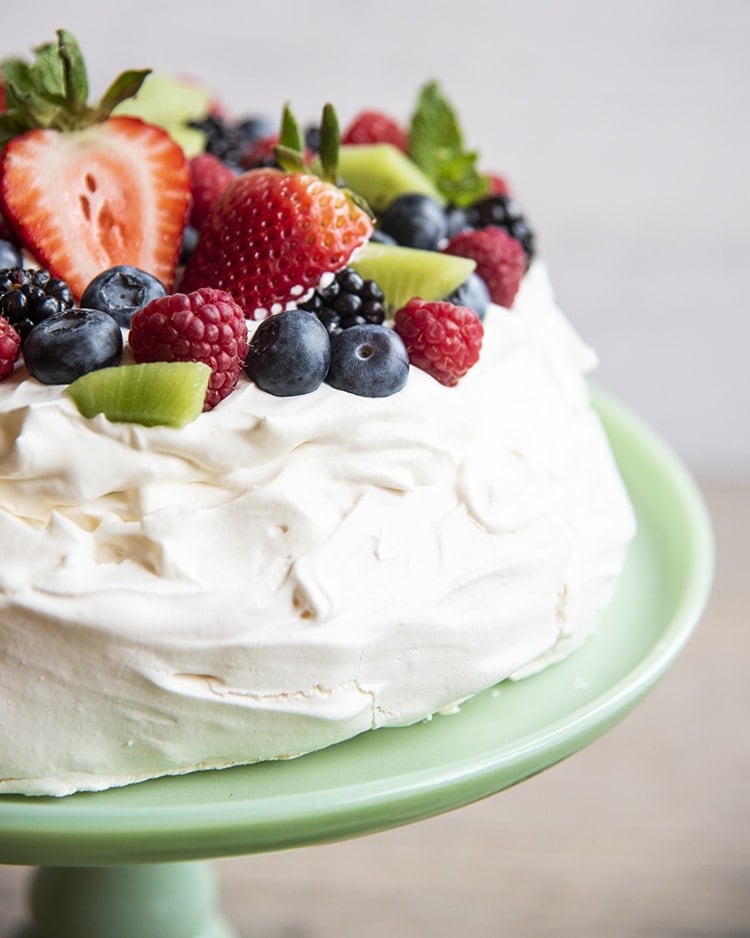
My Australian sister in law first introduced me to pavlova a few years ago, and it is now one of my favorite desserts. She has made it for Christmas dessert, Australia Day, birthdays and more. It’s a gorgeous dessert, that I promise you’ll fall in love with, just like I did.
Pavlova is a stunning meringue based dessert that is cooked at a low temperature for a long time to keep the exterior nice and white.
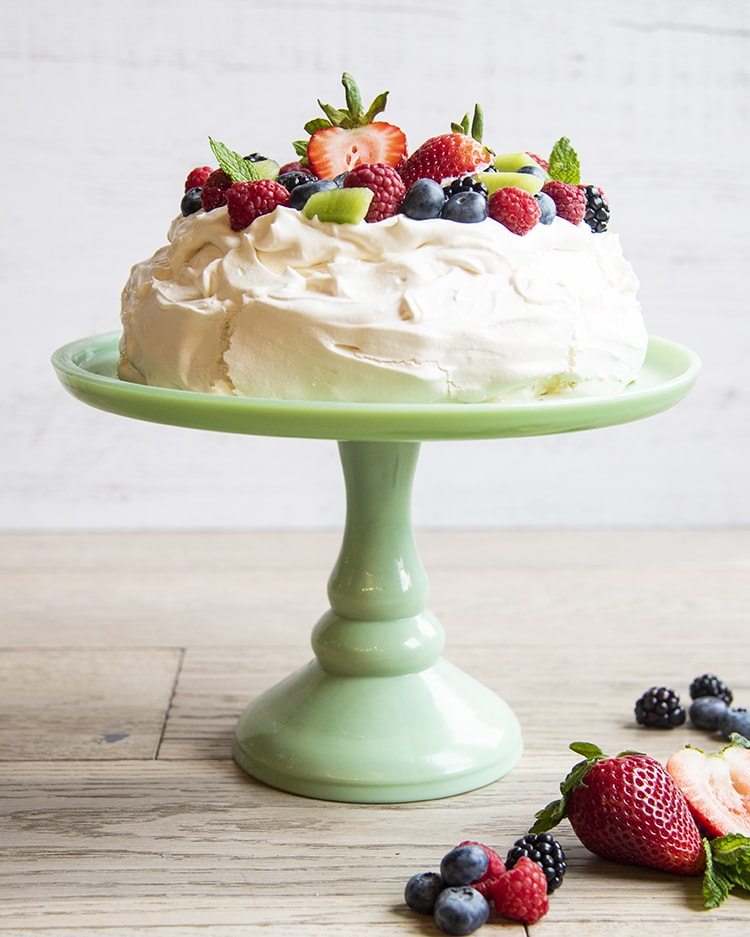
What is pavlova?
Pavlova is a meringue based dessert, meaning its made with mostly egg whites. It is named after the Russian ballerina Anna Pavlova. It is debated whether it was first created in New Zealand or Australia.
It has a delicate and crisp and chewy meringue crust on the outside, with a soft and smooth marshmallowey middle. It is served topped with whipped cream and seasonal fresh fruit.
Pavlova is cooked at a low temperature to keep the outside pale, almost white in color. It’s common to have your mini pavlovas crack a little bit, but we cool it super slowly in the oven to prevent any drastic change of temperature. And thankfully the whipped cream on top can help hide them a bit too.
Pavlova is a naturally gluten free dessert, that is made with egg whites, sugar, vanilla extract, lemon juice, and cornstarch.
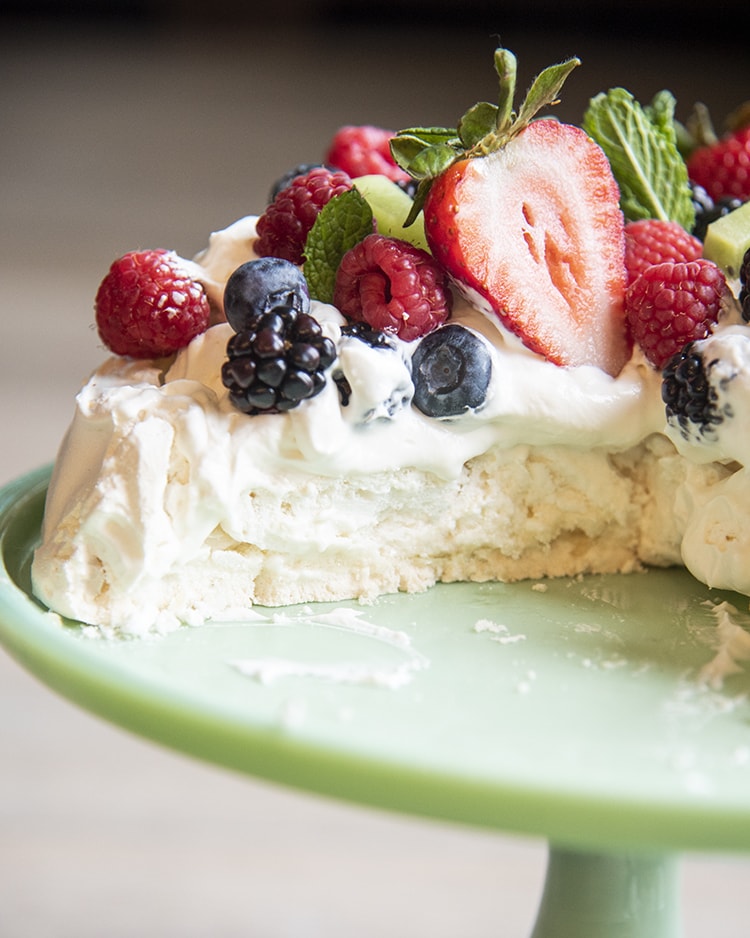
How to make Pavlova?
First you’ll separate your eggs, the yolks from the whites while the eggs are cold from the fridge. But then put the whites in a bowl and let them come to room temperature for a few hours. Draw an 8 inch circle on some parchment paper, then flip the parchment paper upside so you can still see the circle through the paper.
When the egg whites are room temperature, preheat the oven to 300 degrees farenheit. Then beat the egg whites for a few minutes until they start to form soft peaks. Use a hand mixer or stand mixer, unless you have really strong muscles 😉 Continue beating over medium speed while adding in your sugar 1 tablespoon at a time. It’ll end up being 20 tablespoons (1 1/4 cups). Keep mixing for 10-15 minutes until your egg whites start to turn thick and glossy, and have stiff peaks. And you can put a little of the meringue in between your fingers and you don’t feel the sugar grit anymore. Carefully fold in the vanilla extract, lemon juice, and cornstarch.
Spoon the mixture into the circle on the parchment paper then working from the outside to the middle, build up the edges of the pavlova slightly to have a slight indentation in the middle. Place the pav into the preheated oven and lower the temperature to 225 degrees. Bake pavlova in the oven. Open the oven door and prop it open with a wooden spoon, and let the pavlova cool in the oven for a couple hours. Then remove to room temperature to continue cooling.
Pavlova is best when served within a day or two of making it, wrap it up when it’s cool with plastic wrap if you’re not going to eat it right away, and store it in at room temperature. Do not store it in the fridge or it will get moist and won’t have that crunchy shell.
Top it with fresh whipped cream and fresh fruit when you’re ready to serve it up.
I topped mine with strawberries, blackberries, raspberries, blueberries and kiwi. But a very popular Aussie topping is passion fruit, and other tropical fruits.
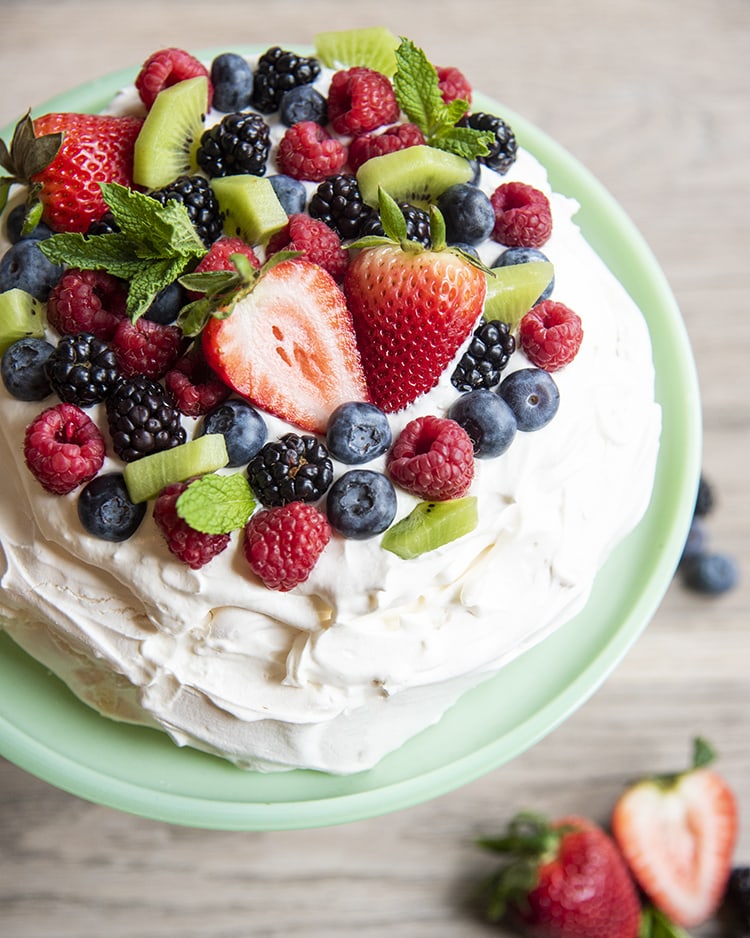
Tips to make a good Pavlova:
- Separate the egg white while the eggs are still cold from the fridge. Cold eggs are easier to separate than warm. Then bring the egg whites to room temperature.
- Use a metal or glass bowl for whisking your egg whites and make sure to wipe it completely dry before mixing. Any water will stop the egg whites from getting nice and fluffy. Don’t use a plastic bowl as it is more porous and can transfer oils and fats from previous recipes into the egg whites.
- Use extra fine (caster) sugar if you can so it is easier to dissolve into the eggs. I made it with regular sugar the first time I made it and didn’t notice much of a difference, so if that’s all you have it will work okay too – or you can blend your sugar in a blender to get it a little finer.
- Very slowly add the sugar into the egg whites. About one tablespoon at a time, until that is mixed into the egg fully. Let your mixer keep mixing and add the sugar in every 30 seconds to every minute.
- Whisk the meringue on medium speed. Do not try and whisk it on high speed to get it to dissolve and fluff faster. It won’t create even air bubbles in the meringue and will be less likely to have big cracks.
- Pavlova needs an acid to help the egg whites hold their fluffy shape. You can use white vinegar, apple cider vinegar or lemon juice for this.
- Draw an 8inch circle on some parchment paper (tracing an 8inch cake pan worked great for me) Then flip the parchment over so you don’t get any pen or pencil on the bottom of the pavlova.
- Pile your pavlova high so you get lots of that soft fluffy middle.
- Meringue is very temperamental, and a lot of things can cause it to crack or sink. It’s best to bake the pavlova on a dry day as excess humidity can cause the pavlova to weep or not keep it’s crispy exterior and turn soft.
- Walking heavily through your kitchen when the pavlova bakes can cause it to crack extra.
- It’s normal and okay if your pavlova cracks. (Every one of mine has cracked a little) That doesn’t mean it won’t still taste delicious.
- If you want to cover up some of the cracks on your pavlova, make a little extra whipped cream and fill them in with some whipped cream.
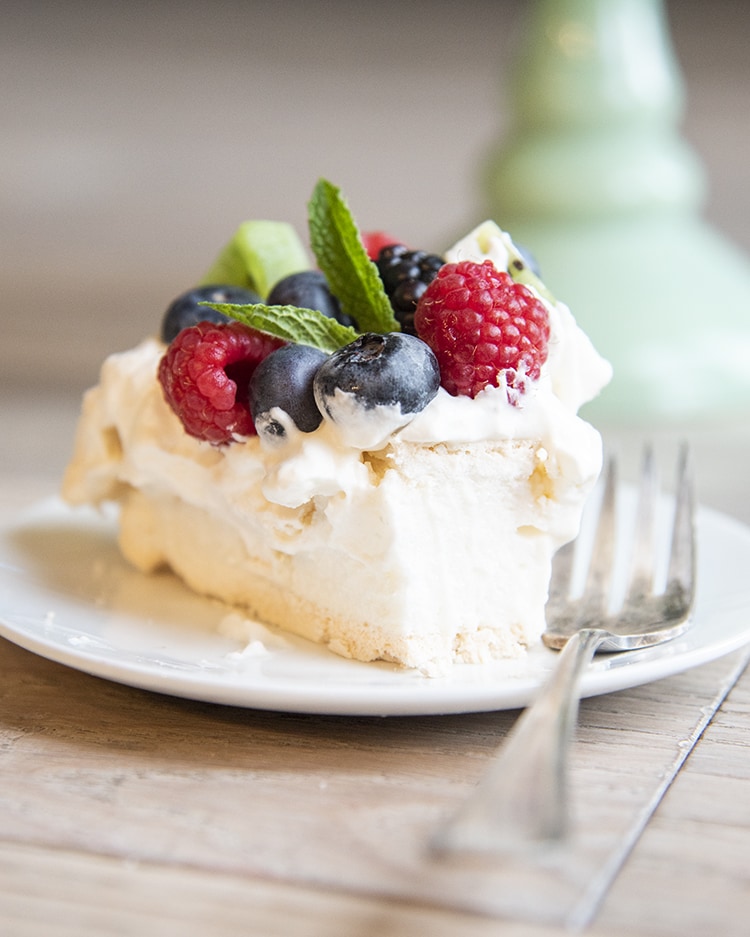
Pavlova is such a delicious dessert for lots of occasions. It’s so good in the spring time for Easter, or a baby shower, or birthday party. Decorate it with cranberries or pomegranate and mint leaves for a Christmas pavlova. Enjoy it with for New Year’s Eve, Thanksgiving, a summer BBQ – you name it.
Ever since I had my first pavlova I am obsessed with them, and I think you will be too. It’s the perfect elegant and delicious dessert. They’re stunning, and beautiful. They’re perfect for people who love nice textures on food with their crispy exterior and soft marshmallow-ey middle.

Looking for more meringue recipes:
- Lemon Meringue Pie
- Meringue Cookies on Baking a Moment
- Easy Baked Alaska on Spend with Pennies
Connect with Like Mother, Like Daughter
Be sure to follow us on social media, so you never miss a single post!
Facebook | Instagram | Pinterest | Email

Pavlova
Ingredients
For the Pavlova:
- 4 large egg whites (if you eggs are smaller use 5)
- 1 1/4 cup ultra fine sugar (regular white granulated is fine if that's all you have - pulse it in a blender or food processor for a few seconds to make it a little more fine)
- 1 tsp vanilla extract
- 1 tsp lemon juice (or vinegar)
- 2 tsp cornstarch
For Topping the Pavlova:
- 2 cups heavy cream
- 1/4 cup powdered sugar
- 1/4 cup diced strawberries
- 1/4 cup raspberries
- 1/4 cup blueberries
- 1/4 cup blackberries
- 2 kiwi (peeled and diced)
Equipment
Instructions
For the Pavlova:
- Separate your egg whites from the yolks straight from the fridge. Put the egg whites in a bowl and allow them to come to room temperature. (You can dispose of, or use your egg yolks in another recipe)
- Preheat the oven to 300 degrees Fahrenheit.
- Draw an 8inch circle on parchment paper. (Use the bottom of an 8inch cake pan to trace). Flip the parchment over and place it on a baking sheet so you can see the circle but the pencil doesn't get on the pavlova.
- Beat the egg whites in a large bowl of a stand mixer or with a hand mixer over medium speed for 3-5 minutes until soft peaks form.
- Continue mixing over medium speed, adding in your sugar 1 tablespoon at a time. Add the sugar in every 30 seconds to 1 minute, allowing the sugar to mostly dissolve in between each addition.
- Once the sugar is all added, continue mixing the egg whites for 5-15 minutes until the sugar is dissolved and the egg whites are thick, stiff and glossy.
- Add in the vanilla extract, lemon juice, and cornstarch and fold them into the egg whites with a rubber spatula.
- Scoop the mixture onto the prepared parchment paper inside the circle.
- Working from the middle to the edges, slightly build up the edges, leaving a slight indent in the middle.
- Place the pan in the oven and lower the oven temperature to 225 degrees.
- Bake the pavlova in the oven for 1 hour until the edges are set and the bottom of the pavlova starts to peel away from the parchment.
- Turn off the oven and open the door a crack and prop it open with a wooden spoon. Allow pavlova to cool in the oven for a few hours.
- Transfer to a cooling rack to cool completely if not already cooled.
- Wrap the pavlova carefully in plastic wrap until you're ready to serve for up to 2 days.
- When ready to serve top pavlova with whipped cream and fresh fruit and serve.
For Topping the Pavlova:
- Add the heavy cream and powdered sugar to a medium size bowl.
- Beat over high speed until thick and stiff peaks are formed.
- Spread heavy cream carefully over the top of the pavlova and use some to fill in the cracks if desired.
- Spread prepared fruit over the top of the heavy cream.
- Slice and serve.
Nutrition
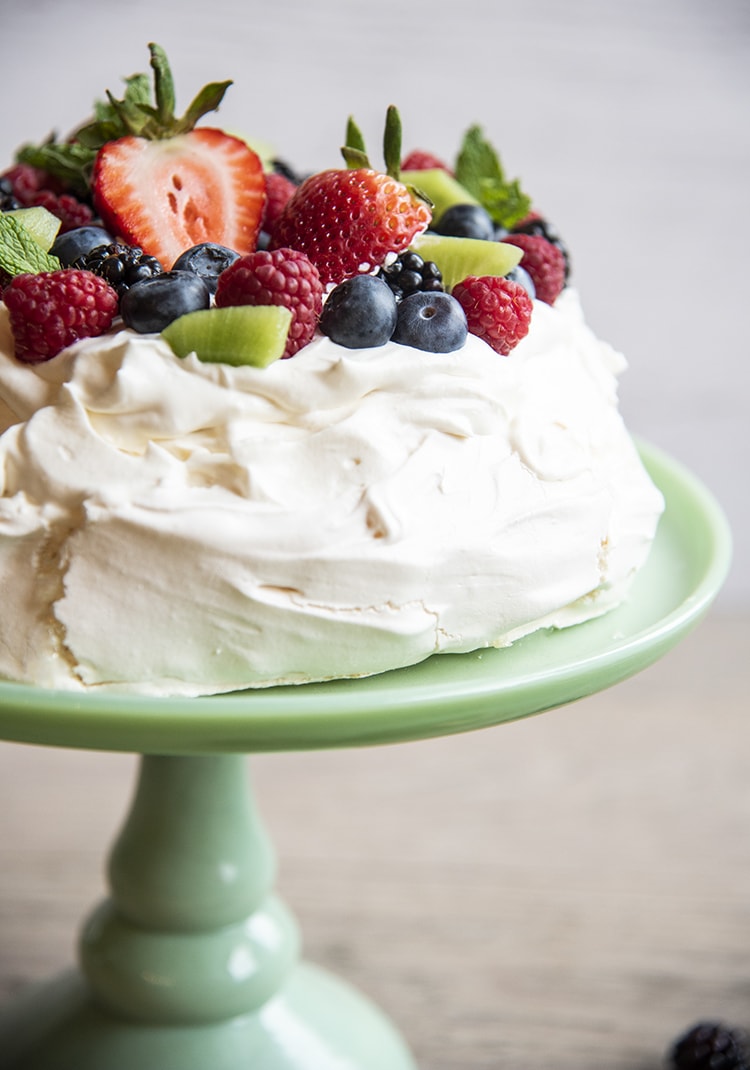

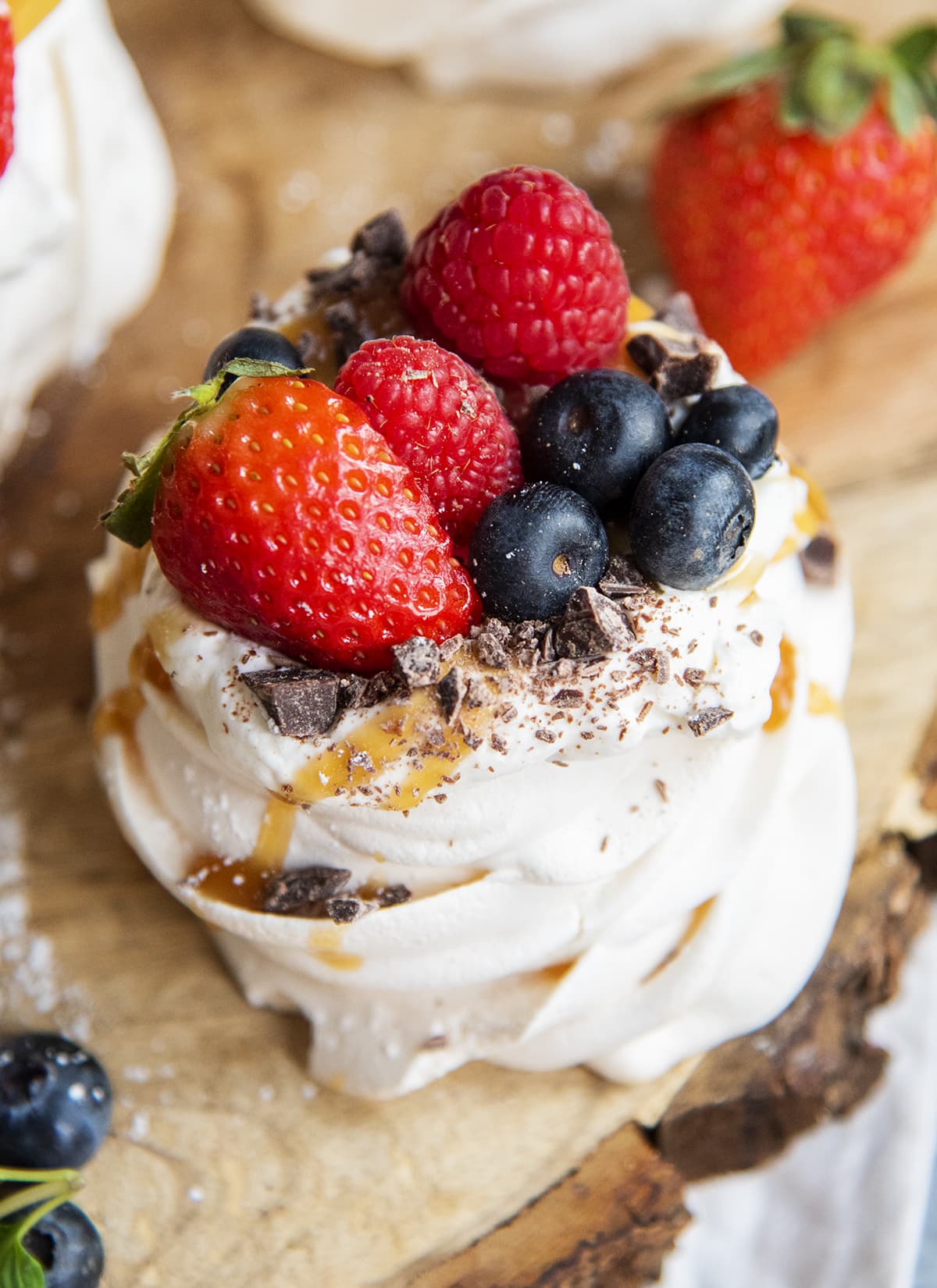
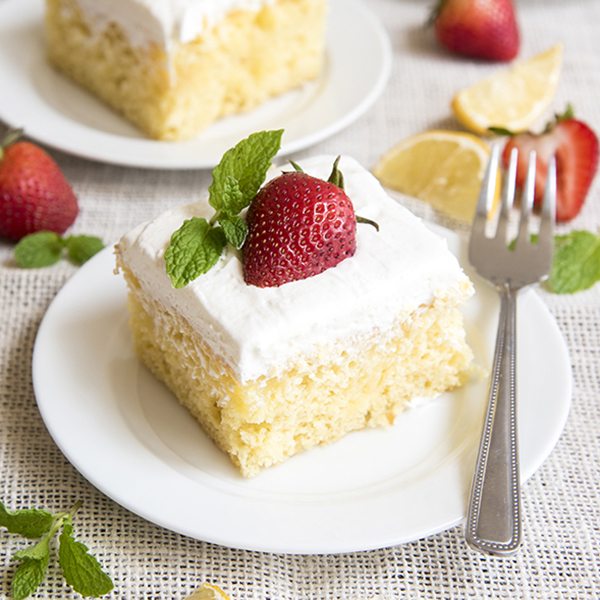


Leave a Reply